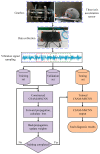Multiscale Convolutional Neural Network Based on Channel Space Attention for Gearbox Compound Fault Diagnosis
- PMID: 37112168
- PMCID: PMC10141628
- DOI: 10.3390/s23083827
Multiscale Convolutional Neural Network Based on Channel Space Attention for Gearbox Compound Fault Diagnosis
Abstract
Gearboxes are one of the most widely used speed and power transfer elements in rotating machinery. Highly accurate compound fault diagnosis of gearboxes is of great significance for the safe and reliable operation of rotating machinery systems. However, traditional compound fault diagnosis methods treat compound faults as an independent fault mode in the diagnosis process and cannot decouple them into multiple single faults. To address this problem, this paper proposes a gearbox compound fault diagnosis method. First, a multiscale convolutional neural network (MSCNN) is used as a feature learning model, which can effectively mine the compound fault information from vibration signals. Then, an improved hybrid attention module, named the channel-space attention module (CSAM), is proposed. It is embedded into the MSCNN to assign weights to multiscale features for enhancing the feature differentiation processing ability of the MSCNN. The new neural network is named CSAM-MSCNN. Finally, a multilabel classifier is used to output single or multiple labels for recognizing single or compound faults. The effectiveness of the method was verified with two gearbox datasets. The results show that the method possesses higher accuracy and stability than other models for gearbox compound fault diagnosis.
Keywords: attentional mechanisms; compound faults; gearboxes; multilabel classification; multiscale feature extraction.
Conflict of interest statement
The authors declare that they have no known competing financial interest or personal relationship that could have appeared to influence the work reported in this paper.
Figures


















Similar articles
-
Gearbox Fault Diagnosis Based on MSCNN-LSTM-CBAM-SE.Sensors (Basel). 2024 Jul 19;24(14):4682. doi: 10.3390/s24144682. Sensors (Basel). 2024. PMID: 39066079 Free PMC article.
-
Wavelet Packet Decomposition-Based Multiscale CNN for Fault Diagnosis of Wind Turbine Gearbox.IEEE Trans Cybern. 2023 Jan;53(1):443-453. doi: 10.1109/TCYB.2021.3123667. Epub 2022 Dec 23. IEEE Trans Cybern. 2023. PMID: 34767518
-
A zero-shot attribute-embedded model with a feature difference mapping sigmoid function for compound fault diagnosis of rotating machinery.ISA Trans. 2025 Feb;157:451-465. doi: 10.1016/j.isatra.2024.12.026. Epub 2024 Dec 18. ISA Trans. 2025. PMID: 39721863
-
Machine learning for fault analysis in rotating machinery: A comprehensive review.Heliyon. 2023 Jun 22;9(6):e17584. doi: 10.1016/j.heliyon.2023.e17584. eCollection 2023 Jun. Heliyon. 2023. PMID: 37408928 Free PMC article. Review.
-
A Review of Fault Diagnosis Methods for Rotating Machinery Using Infrared Thermography.Micromachines (Basel). 2022 Sep 30;13(10):1644. doi: 10.3390/mi13101644. Micromachines (Basel). 2022. PMID: 36295997 Free PMC article. Review.
Cited by
-
Gearbox Fault Diagnosis Based on MSCNN-LSTM-CBAM-SE.Sensors (Basel). 2024 Jul 19;24(14):4682. doi: 10.3390/s24144682. Sensors (Basel). 2024. PMID: 39066079 Free PMC article.
-
Efficient Gearbox Fault Diagnosis Based on Improved Multi-Scale CNN with Lightweight Convolutional Attention.Sensors (Basel). 2025 Apr 22;25(9):2636. doi: 10.3390/s25092636. Sensors (Basel). 2025. PMID: 40363076 Free PMC article.
-
Biomedical named entity recognition using improved green anaconda-assisted Bi-GRU-based hierarchical ResNet model.BMC Bioinformatics. 2025 Jan 30;26(1):34. doi: 10.1186/s12859-024-06008-w. BMC Bioinformatics. 2025. PMID: 39885428 Free PMC article.
References
-
- Zhao Z., Wu J., Li T., Sun C., Yan R., Chen X. Challenges and opportunities of AI-enabled monitoring, diagnosis & prognosis: A review. Chin. J. Mech. Eng. 2021;34:56.
-
- Zhou J., Qin Y., Luo J., Zhu T. Remaining useful life prediction by distribution contact ratio health indicator and consolidated memory GRU. IEEE Trans. Ind. Inform. 2022 doi: 10.1109/TII.2022.3218665. - DOI
-
- Hajnayeb A., Ghasemloonia A., Khadem S., Moradi M.H. Application and comparison of an ANN-based feature selection method and the genetic algorithm in gearbox fault diagnosis. Expert Syst. Appl. 2011;38:10205–10209. doi: 10.1016/j.eswa.2011.02.065. - DOI
-
- Bordoloi D., Tiwari R. Support vector machine based optimization of multi-fault classification of gears with evolutionary algorithms from time–frequency vibration data. Measurement. 2014;55:1–14. doi: 10.1016/j.measurement.2014.04.024. - DOI
-
- Hu Q., Si X.-S., Zhang Q.-H., Qin A.-S. A rotating machinery fault diagnosis method based on multi-scale dimensionless indicators and random forests. Mech. Syst. Signal Process. 2020;139:106609. doi: 10.1016/j.ymssp.2019.106609. - DOI
LinkOut - more resources
Full Text Sources

